The Ultimate Guide to Replacing All Teeth: Options, Procedures, and Recovery
Basics of implants — strong, natural tooth restoration with a metal post.

Replacing all teeth is a significant decision for dental patients seeking the best solution for their oral health needs. Traditionally, dentures have been the go-to option, offering a removable solution that restores basic function and aesthetics. However, modern dentistry now presents implant-supported solutions, which are increasingly popular due to their stability and natural feel. Each method presents its own set of advantages and limitations that must be considered carefully. Dentures are generally more affordable and faster to fit, but they may require frequent adjustments and might lack comfort for some. Conversely, implant-supported solutions, while involving a more complex procedure and higher upfront costs, offer unparalleled durability and a natural appearance, making them a worthwhile investment for many patients.
When deliberating on the best option, it is essential to weigh these benefits and limitations against personal needs and lifestyle. Implant-supported solutions, like All-on-4, are particularly beneficial for those looking for a permanent and more secure option. They eliminate many concerns associated with traditional dentures, such as slippage during eating or speaking. Additionally, they can help in maintaining jawbone integrity, which can deteriorate when teeth are missing or when dentures are used. Therefore, for those seeking functionality and longevity, implanted bridges represent a robust option. It’s crucial to have a detailed discussion with your dental professional to understand which solution best fits your situation, preferences, and budget.
Comprehensive Guide to Tooth Replacement Procedures
The journey to replace all teeth begins with a thorough evaluation to determine the most suitable treatment approach. At this stage, dentists conduct comprehensive exams, including dental X-rays and 3D imaging, to assess the condition of your oral health. Once all necessary data is compiled, a personalized treatment plan is created, outlining the stages involved in the procedure and recovery. For those opting for traditional dentures, the process typically involves creating molds of your mouth to craft a custom-fit appliance. On the other hand, dental implants require oral surgery to insert titanium posts into the jawbone, serving as sturdy anchors for replacement teeth.
Following the surgical placement of implants, a healing period is necessary to ensure the implants integrate securely with the jawbone. This process, known as osseointegration, is pivotal for the long-term success of dental implants. Once the posts are fully integrated, permanent replacement teeth or prosthetics can be attached. Throughout each step, professionals ensure minimal discomfort and optimize results for the patient’s comfort and satisfaction. By understanding each phase of the procedure, patients can have realistic expectations and prepare adequately for their journey towards a restored smile.
Analyzing Cost, Recovery Time, and Expected Outcomes
Navigating the financial aspect of complete tooth replacement is crucial, as it can vary significantly based on the chosen method. Traditional dentures generally represent a more cost-effective option upfront; however, ongoing maintenance and potential replacements should be factored into long-term costs. Implant-supported solutions, while more costly initially, often prove to be economically advantageous over time due to their durability and low maintenance needs. Recovery timelines also differ; dentures typically offer quicker transitions, allowing patients to adapt almost immediately, whereas implant procedures might require months for full recovery and adaptation.
The expected outcomes in terms of functionality and aesthetics can vary, but both traditional dentures and implant-supported solutions aim to restore a patient’s ability to eat, speak, and smile confidently. Patients opting for implant-supported solutions often experience improved oral function and stability, making them indistinguishable from natural teeth. The choice between these options should be guided by individual priorities, financial considerations, and willingness to undergo different recovery timelines. Understanding these factors equips patients with the knowledge needed to make informed decisions about their oral healthcare journey.
Advancements in Denture and Implant Techniques
Dentistry has seen remarkable advancements that significantly influence the choice between traditional dentures and dental implants. This era of dentistry empowers patients with choices that are both effective and adaptable to changing healthcare landscapes. As technology advances, it will continue to open new doors for those seeking to replace their entire dentition.
Are you ready to restore your smile at our skilled and trusted dental practice? Don’t wait to get the smile of your dreams with us. Get in contact with our doctor, Dr. Arthur Greyf, and our exceptional team at our practice to schedule an appointment today!

